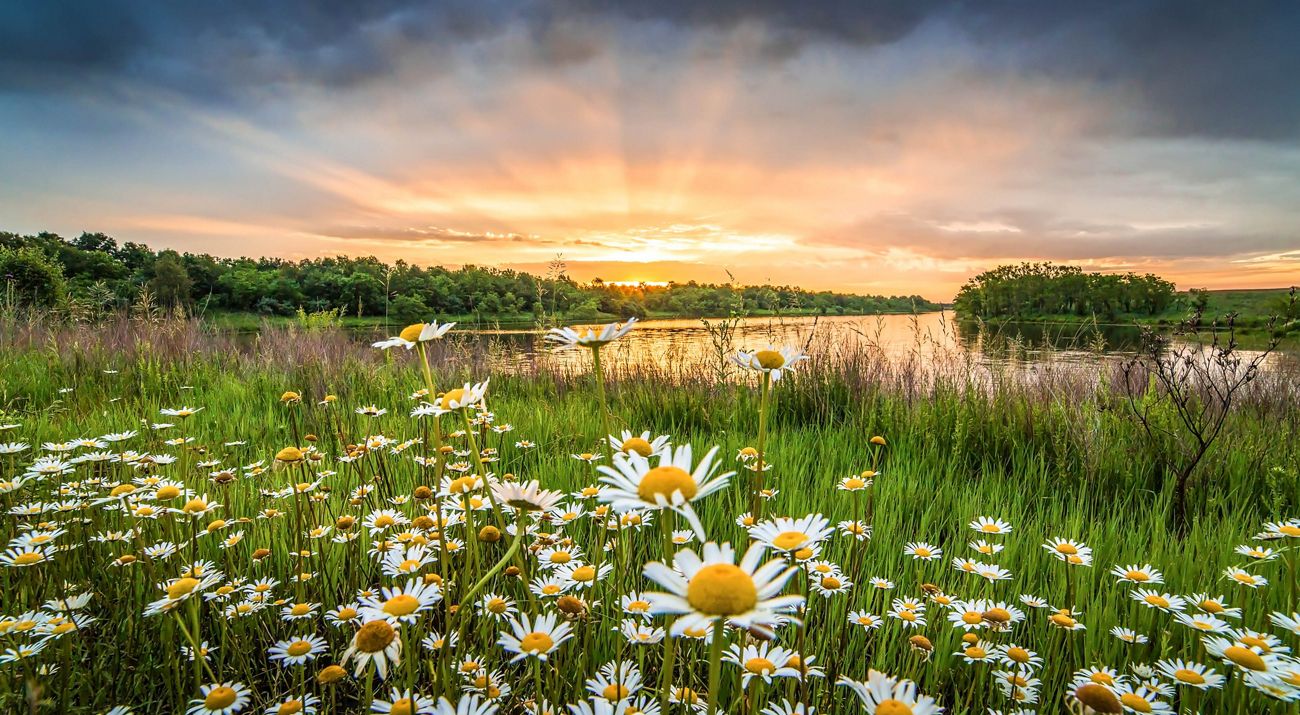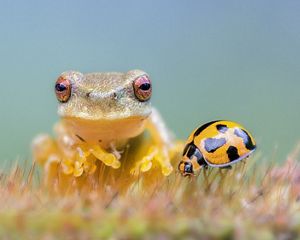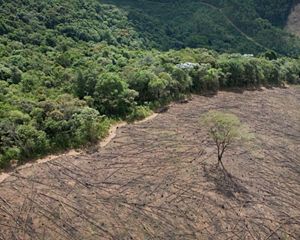
Nature's Future Is Our Future
The Nature Conservancy’s CEO Jennifer Morris shares why it’s time for radical collaboration on climate change & biodiversity loss—now more than ever.
As a lifelong conservationist and now CEO of The Nature Conservancy, I am an impatient optimist. I hear the clock ticking on climate change. I see the threats to biodiversity and loss of nature with clear eyes. I listen to the stories from vulnerable populations most directly and immediately affected by droughts, intense storms, and other increasingly severe natural disasters.
And yet, I am optimistic. I believe that the global community can come together and enact the right policies, shift industries toward a more sustainable path, and empower local communities to protect the resources that sustain them, for one, simple reason: I believe in the power of humanity to act.
The nature crisis is a human crisis
I’ve always been a nature lover. Even as a kid, I would spend my summers exploring the small forest near my family’s home in Atlanta, Georgia, scribbling in my notebook the species names of birds and trees I could identify. But, twenty-seven years ago, as an English teacher in a small rural community in Northern Namibia, I began to fully understand our capacity for building a better future by protecting nature.
After a day of helping women collect firewood and digging boreholes to access fresh water from the aquifer, my friend Ria and I sat outside under a full moon to look at pictures from her youth. She shared photos of her community surrounded by lush forests and told stories about fishing and harvesting fresh corn.
Her life as a grown woman was much different: her home was surrounded by drought-stricken fields, and she spent much of her day traveling far distances to collect water and firewood for her family—distances that continued to grow due to deforestation. These long journeys came with increased risk of violence, less time at home, fewer hours studying in my class, and no chance to find a paying job.
That night I began to understand on a deeper level how connected our health and economic wellbeing are to the health of our local environment. From that moment, I set out to devote my career to protecting nature and bettering the lives of all who depend on it.
And I can’t imagine a more urgent time to be wholly dedicated to this work than now.
Climate change and biodiversity loss are two of the greatest threats the world faces. These twin crises pose enormous risks for communities and economies around the world. A failure to act on them is to be complicit in exacerbating the challenges we face as a result of the current COVID-19 pandemic, not to mention global conflict, income inequality, and other hardships that have persisted for generations. Action is not only a moral obligation, it is an existential imperative. And all paths to a better world depend on our ability to protect the lands and waters that provide us all with clean air and water, healthy food and a stable climate.
Collaboration is our strongest lever for change
Change at a meaningful scale cannot be achieved by any one organization alone. It cannot even be achieved by many likeminded organizations. Scientists, Indigenous peoples, and environmentalists have been shouting from the rooftops about the degradation to our ecosystems and changes to our climate for decades. We were warned about severe impacts to future generations. Well, those future generations are here now. And our efforts to date, while important and meaningful, have been insufficient to achieve systemic change.
For tangible, lasting results we need to engage in radical collaboration—across sectors, across beliefs, across knowledge bases.
This spirit of collaboration is part of The Nature Conservancy’s DNA—and a big reason why I was drawn to lead this great organization. For 69 years, TNC has rallied people together around a shared vision to protect and care for nature. As our impact grew across all 50 states and more than 70 countries and territories, we brought even more partners to the table. TNC’s science-first, nonpartisan approach to working with government leaders helps drive policies that incentivize the protection of nature while balancing the economic and health needs of communities. Through corporate partnerships, we engage with large, influential companies, and leverage scientific insights to influence change up and down supply chains and across industries. And together with investors and lenders, we are unlocking new sources of capital to extend the impact of our conservation work.
Quote
For tangible, lasting results we need to engage in radical collaboration—across sectors, across beliefs, across knowledge bases.
Just as critical to the success of our work, and the health of our planet, is engaging and supporting Indigenous peoples and local communities who have stewarded their lands since time immemorial. Strengthening their agency and helping them manage natural territories in a way that enhances livelihoods will also drive conservation outcomes for a quarter of the world’s lands—areas rich in biodiversity that also store an immense 17% of the planet’s forest carbon.
Science-based conservation for a changing world
Underpinning these collaborations is rigorous science and innovation to keep pace with an ever-changing world—from launching world-class spatial mapping that helps monitor protected areas and study migration patterns, to leveraging our financial and deal-making expertise that drives private investment in nature, to scaling up the protection and restoration of forests, grasslands and wetlands that sequester carbon from the atmosphere. Our science-based, collaborative approach helps us identify where to work, how to do it, and who we need on board to get it done.
The current pandemic has made considerable impacts to our conservation efforts and the people we work with around the world. We’ve had to pause important field projects, like clearing invasive plants to avoid water loss and protect biodiversity in the watersheds of Greater Cape Town, South Africa—a job that provided income to more than 120 local people. In places like India, we are rethinking how we can support rural communities, as hundreds of thousands of migrants return to their villages after leaving locked-down cities. And what we had hoped would be the “Super Year for Nature” is now in flux, as major international forums, where we intended to push for big policy changes, have been postponed.
We can’t ignore these setbacks, but we can do everything in our power to focus on the long-term health of our organization, our communities, and our planet. That’s why we will be doubling down on the areas where we know we can have the greatest impact—protecting the planet’s lands, oceans, and freshwater and addressing climate change. Given the urgency of our mission we must increase our focus on these key areas, direct our resources to them to ensure results, and—in this data-rich era—strengthen our ability to measure our impact. And, just as important, we will hold ourselves accountable to our values in all we do, conducting ourselves with integrity beyond reproach and treating all of our colleagues, volunteers, and partners with dignity and respect.
Quote
These are uncertain times, but around the world we are seeing now how quickly we are capable of responding to a global crisis when we work together.
The next decade of conservation will look different as society focuses on rebuilding our economies and communities in the wake of the pandemic, and this period ahead will be critical for determining the trajectory of our planet’s health. As we chart a new course forward, nature will matter more than ever—and we have the opportunity to highlight its crucial role in sustaining our health, our livelihoods and our well-being. At The Nature Conservancy, we will be shining a spotlight on nature-based solutions that are key to addressing climate change, filtering and cleaning air and water, protecting coastal communities from increasingly severe storms and sustaining local economies.
These are uncertain times, but around the world we are seeing now how quickly we are capable of responding to a global crisis when we work together. It’s a real source of hope. And it is this focus and scale of action that our other longer-term crises demand in order to create a more sustainable world for future generations.
This role is more than just a job for me—it is a calling. And I know I’m not alone. I’m surrounded by thousands of colleagues, supporters, volunteer leaders, and partners who have dedicated their life’s work to protecting and restoring natural places. I am so excited to join them, and all of you. Only together can we act on the level our planet demands.
Who We Are
The Nature Conservancy is a global environmental nonprofit working to create a world where people and nature can thrive.







